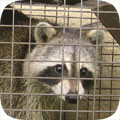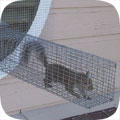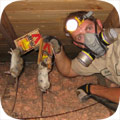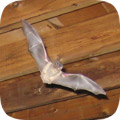- winfield@wildlifeanimalcontrol.com
Call 7am-7pm for a free quote:
316-665-4842
Winfield Wildlife Animal Control
Professional Wildlife Removal Company Servicing Winfield, KS
If you have a problem with wildlife in your Winfield home, your best option is to hire a company that specializes in Kansas wildlife removal only. This is a specialty business, and regular pest control companies do not use the proper techniques to solve animal problems. I have spent many years reviewing Kansas and Winfield, and I recommend the following:
Wichita Wildlife Removal
Cell Phone: 316-665-4842
NOTE: If you have a dog or cat problem, call Cowley County Animal Services: (620) 221-5551

Wichita Wildlife Removal specializes primarily in removing animals from attics of homes and buildings - this includes squirrels in attics, raccoons, and rats or mice in homes. Kansas also has a documented problem with
bats in buildings, and Wichita Wildlife Removal is specially trained in bat removal. They also perform general wildlife trapping services, such as the capture and removal of skunks or opossums on the
property. Call 316-665-4842 to discuss your critter problem and schedule a same-day or next-day appointment. Click here to learn more about what prices we charge in 2020.
When hiring a company to solve your wild animal problem, you want these features:
- Specializes in wildlife removal, not pest control
- Fully Kansas and Cowley County licensed and insured
- Works 7 days per week (critters don't take weekends off)
- Performs full building inspections: enters and inspects attic
- Performs exclusion repairs, with guarantee against animal re-entry
- Offers cleanup of biohazardous wildlife waste
Wichita Wildlife Removal is a full-service Winfield wildlife removal company. This is very different from a regular Winfield pest control company. The pest control companies spray poison to kill insects. This is not at all
similar to wildlife removal. Wichita Wildlife Removal performs a full inspection of the home or property, and determines why the animal(s) are there, and if inside a building, how the animals got inside. All
animals (including rodents) are trapped and removed, or if possible, removed from the building using special exclusion devices. Once the animals are gone, preventative repairs are essential, and
cleanup is sometimes recommended.
 Winfield wildlife trapping - it's not as simple as it may seem. It's illegal in Kansas to trap without a license. Trap type is very important and there are many different types, bait is somewhat relevant, trap placement
is vital, and there are dozens of small things that are very important to know.
Safety is a concern. Then once the animal is trapped, it must be removed and dealt with in the proper manner according to Kansas law. We offer Winfield raccoon removal. Read more about how to get rid of raccoons.
Winfield wildlife trapping - it's not as simple as it may seem. It's illegal in Kansas to trap without a license. Trap type is very important and there are many different types, bait is somewhat relevant, trap placement
is vital, and there are dozens of small things that are very important to know.
Safety is a concern. Then once the animal is trapped, it must be removed and dealt with in the proper manner according to Kansas law. We offer Winfield raccoon removal. Read more about how to get rid of raccoons.
 Animals in attics - this is our specialty at Wichita Wildlife Removal. Many types of animals like to live in attics. This includes squirrels, raccoons, rats, mice, bats, birds, and even possums. Critters like to go into attics for a safe place to live
and raise their young. Removing animals from attics is very complex work, partly because of the presence of baby animals. If you need Winfield squirrel removal, we can remove all the squirrels from your attic, and seal out any future ones. Read more about how to get rid of squirrels.
Animals in attics - this is our specialty at Wichita Wildlife Removal. Many types of animals like to live in attics. This includes squirrels, raccoons, rats, mice, bats, birds, and even possums. Critters like to go into attics for a safe place to live
and raise their young. Removing animals from attics is very complex work, partly because of the presence of baby animals. If you need Winfield squirrel removal, we can remove all the squirrels from your attic, and seal out any future ones. Read more about how to get rid of squirrels.
 Rodent control must be done in a very specific way. First off, the most important thing is that all the openings that rats and mice can use to enter a house be sealed. Then all the rodents must be physically trapped and removed.
Never, ever use poison! Most Winfield exterminators will just use this lazy poison technique to kill rodents, and it causes more harm than good - dead stinky rats, and it doesn't solve the problem. Call us for correct Winfield rat removal. Read more about how to get rid of rats.
Rodent control must be done in a very specific way. First off, the most important thing is that all the openings that rats and mice can use to enter a house be sealed. Then all the rodents must be physically trapped and removed.
Never, ever use poison! Most Winfield exterminators will just use this lazy poison technique to kill rodents, and it causes more harm than good - dead stinky rats, and it doesn't solve the problem. Call us for correct Winfield rat removal. Read more about how to get rid of rats.
 Bat removal is a highly specialized task. Kansas is known to have colonizing bats who often live in buildings. Bats love attics. If not removed, the colony can grow to a very large size over the years. The bat droppings are often corrosive and
cause health risks. The same goes for bird droppings on or in buildings. We perform Winfield pigeon removal and bird control. But our specialty is Winfield bat removal. We remove 100% of the bat colony and seal the building so that it's totally bat-proof. Read more about how to get rid of bats.
Bat removal is a highly specialized task. Kansas is known to have colonizing bats who often live in buildings. Bats love attics. If not removed, the colony can grow to a very large size over the years. The bat droppings are often corrosive and
cause health risks. The same goes for bird droppings on or in buildings. We perform Winfield pigeon removal and bird control. But our specialty is Winfield bat removal. We remove 100% of the bat colony and seal the building so that it's totally bat-proof. Read more about how to get rid of bats.
 If you have animals inside a house, no job is complete without proper exclusion repairs. If you simply hire a Winfield trapper who only removes the critters, then the problem will return. You need to hire a Winfield wildlife control company that identifies 100% of the animal entry points
into your building, and seals them shut with professional repairs. In addition, in many cases animals have left waste or contamination behind, and you'll want a company that can provide professional cleaning services. Wichita Wildlife Removal does both.
If you have animals inside a house, no job is complete without proper exclusion repairs. If you simply hire a Winfield trapper who only removes the critters, then the problem will return. You need to hire a Winfield wildlife control company that identifies 100% of the animal entry points
into your building, and seals them shut with professional repairs. In addition, in many cases animals have left waste or contamination behind, and you'll want a company that can provide professional cleaning services. Wichita Wildlife Removal does both.
The above are just some of the services offered by Wichita Wildlife Removal. We also trap and remove animals that destroy lawns, such as moles, or digging animals. Sometimes animals like opossums will live under buildings, steal pet food, raid garbage cans, etc.
Read about how to get rid of opossums. Skunks commonly live under sheds or decks, and set up a den. We can trap and remove them without them spraying. Read about how to get rid of skunks. Wichita Wildlife Removal
also provides dead animal removal in Winfield. If you need help with any other wildlife conflict, from a fox, beaver, groundhog, or any other critter, we can solve it. We also do Winfield snake removal - most of the snakes in Kansas are not venomous, but
call us if you want safe removal, or read about how to get rid of snakes in Winfield. And remember, we are a private business, not Cowley County Animal Control Services, so if you have a dog or cat problem, call the County at (620) 221-5551.
Cowley County animal services does not handle any wildlife issues.
Wichita Wildlife Removal: 316-665-4842
Winfield Pricing Info For Year 2020
 Every wildlife removal situation is different, from the species of animals involved, the location of the animal inside a house or outside, the extent of repairs or cleanup, etc. It's impossible to give one-size-fits-all prices. Examples MIGHT include:
Every wildlife removal situation is different, from the species of animals involved, the location of the animal inside a house or outside, the extent of repairs or cleanup, etc. It's impossible to give one-size-fits-all prices. Examples MIGHT include:
Small Job: For example, a one-stop job to remove an animal in the yard: $100 on up
Medium Job: For example, getting critters out of your house with minor repairs: $300 on up
Large Job: For example, a project involving many service trips and complex work: $500 on up
Give us a phone call now and tell us about your wildlife issue and we will be able to give you a price estimate over the phone. If you're cool with it, we can schedule a same-day or next-day appointment if you like. Our prices are fair, and a good value because we do the job right, the first time.
Winfield Wildlife Tip #1:
What Is A Opossum's Mating Habits, When Do They Have Babies, How Do They Raise Their Young?
Possums are large rats that are often found in wild areas. However, from past few years, some of these creatures have shifted to urban areas as well. Being omnivorous creatures, possums can survive on almost anything. They can eat fruits, vegetables, fish, frogs, some types of snakes and even remains of some dead animals. It makes their survival quite easier, and due to a lesser number of natural predators, they live a long life. Many people are interested to know about mating habits of possums. If you are also searching for such details, this article is useful for you.
The breeding season of possums usually begins in the month of January, and it continues up to the middle of the November. Being marsupial creatures, possums generally give birth to undeveloped babies and then make efforts to raise them by providing complete care. The generally pass within 12 days of breeding; however, 5 to 10 pups crawl into mother's pouch for survival. All these babies get firmly attached to the teat of their mother.
Note that undeveloped babies need warmth and care for survival and they get all this in mother's pouch. Until these babies grow enough to survive independently, they live safely in the mother's pouch. You will be surprised to know that this pouch is sealed so well that even if the mother swims, the babies will remain dry inside. Mother takes care of their food and essential needs while carrying them everywhere on tall trees in the wild areas.
The time when babies become 60 to 70 days old, they gain a size somewhat equal to the mouse, and at this stage, they become able to crawl out of mother's pouch. They will simply explore the surrounding area and will return to the pouch to have their food. After 80 to 90 days of their life cycle, babies become able to ride on mother's back and will visit the area safely. They simply attach their tail and feet firmly to the fur on mother's body to make a safe contact. Many people believe that female or mother possums carry their babies on their tail, but this is just a myth, nothing else. Babies either stay in the pouch or ride on the back of the mother possum.
Up first 3 months of their life cycle, babies are completely dependent on their mother for survival. After the age of 3 and half months, these babies become capable enough to climb up and down to their dens on the trees and start learning to collect their food. Once the babies become completely independent and know how to manage their routine food, they will get separated from mother and will set up their own territory for survival. Dispersion of babies from mothers signifies the last phase of one breeding season, and then they become ready for the new one. Soon they will find a new partner to mate and have babies.
Winfield Wildlife Tip #2:
Kansas Wildlife Information:
Kansas State mammal: American bison
State reptile: Ornate box turtle
State amphibian: Barred tiger salamander
State insect: European honey bee
Kansas was once home to the highest number of Native American tribes in the United States (before it became the United States). Those tribes either lived in permanent locations along the river channels or were nomadic, hunting bison and following the herds. Wild bison are no longer present in Kansas, such was the complete devastation brought on by over-hunting and conversion of prairie into farmland. Approximately two-thirds of the state exists in the Great Plains, while the last third is essentially comprised of forests and gentle hills. Residents of the state call it 'flat as a pancake', and recent studies have proven them correct; Kansas is considered the flattest state in the country. While that point is debatable based on measuring techniques, it doesn't change the fact that most of the animals in this region are those that thrive in open spaces. Kansas is warm and wet as well as warm and dry, all depending on which area of the state you reside in. Snowfall is common, and severe weather is often a daily occurrence. Not only does Kansas suffer from violent thunderstorms, those storms often dredge up dangerous hail and tornados.
Like bison, other animals have been extirpated from Kansas including mountain lions, gray wolves, black bears, and grizzly bears. Now, the most prominent predators in the state are coyotes and bobcats. These mid-level predators have a variety of small animals to feast on, leaving the large grazers often off the radar.
Large animals in Kansas are elk, white-tailed deer, pronghorns, and mule deer. Moose were once native to the state but have since been extirpated. Wild hogs are also present, and these are the most common hooved animals that fall prey to the carnivores.
Pest animals are numerous because of the high number of rodents living in a grass-oriented region. Kansas has an abundance of mice and rats including deer mice, cotton rats, woodrats, grey squirrels, fox squirrels, pocket gophers and prairie dogs.
If the rodents don't get you, the other pest animals just might. This state has plenty of raccoons, armadillos, skunks, badgers, minks, foxes, rabbits, hares, snakes, and bats. In fact, there are 16 different species of bats living in Kansas, waiting for a home with a warm, dry attic to sneak into.
You can always call Wichita Wildlife Removal, any time of day, at 316-665-4842, for a price quote for Winfield wildlife control services. I am confident that this is the best choice amongst wildlife removal companies in Winfield, KS.





































